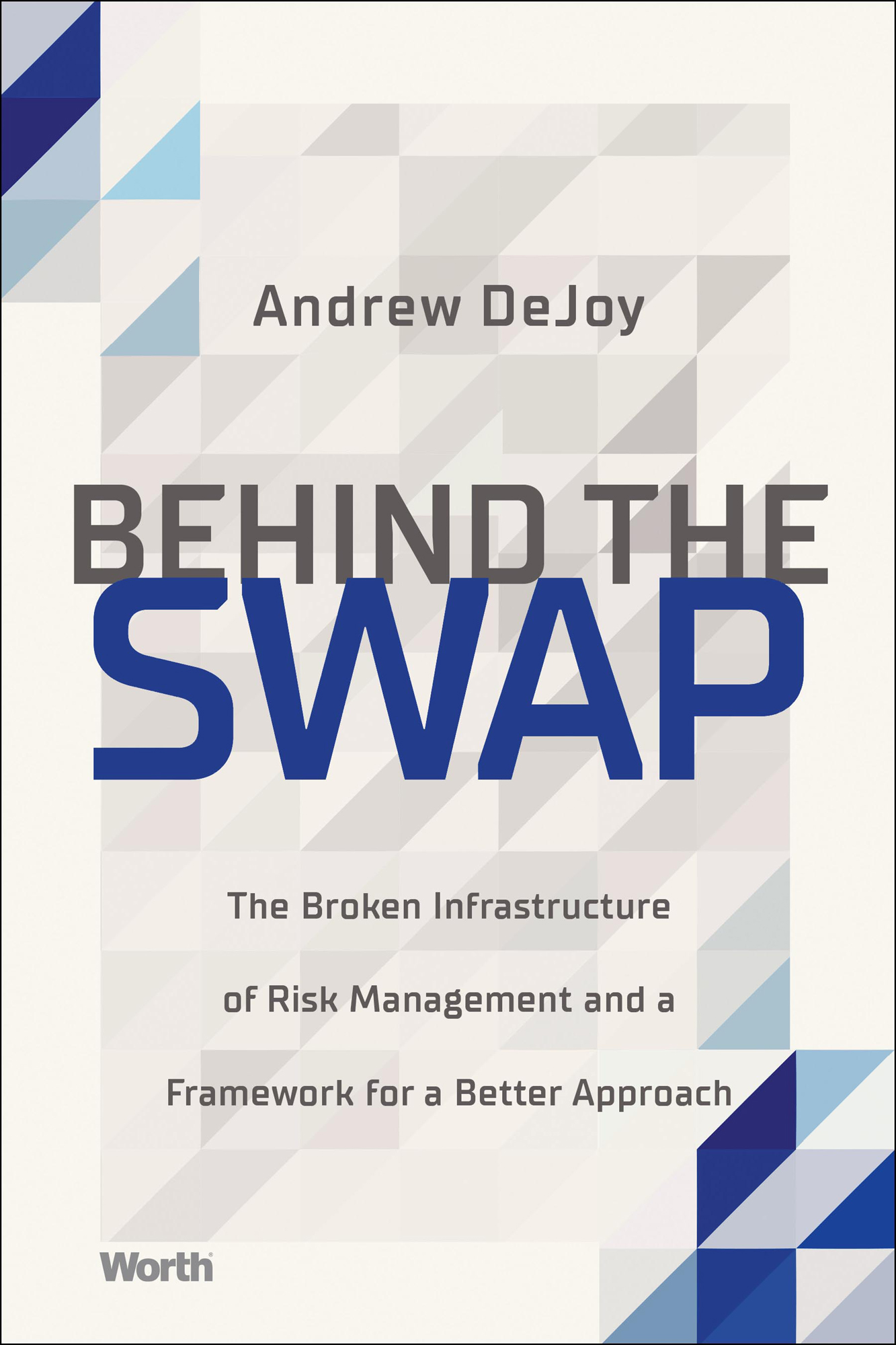CONTENTS
Guide
Andrew DeJoy
Behind the Swap
The Broken Infrastructure of Risk Management and a Framework for a Better Approach
Worth
Behind the Swap:
The Broken Infrastructure of Risk Management and a Framework for a Better Approach
2022 by Andrew DeJoy
All rights reserved.
No part of this book shall be reproduced or transmitted in any form or by any means, electronic, mechanical, magnetic, and photographic, including photocopying, recording or by any information storage and retrieval system, without prior written permission of the publisher.
No patent liability is assumed with respect to the use of the information contained herein. Although every precaution has been taken in the preparation of this book, the publisher and author assume no responsibility for errors or omissions. Neither is any liability assumed for damages resulting from the use of the information contained herein.
This book references data and definitions published by The Bank for International Settlements (BIS). Neither the data nor the definitions are official BIS materials. All usages and analyses of BIS content are the authors own and are in no way endorsed by BIS. The author is not affiliated with BIS in any way. Any mistakes regarding BIS content are the authors own. Published by Forefront Books.
Interior Layout: LParnell Book Services
Jacket design by Charles Brock/Brock Book Design Co.
Jacket Image by Deposit Photos
ISBN: 978-1-63763-067-9 print
ISBN: 978-1-63763-068-6 e-book
ACKNOWLEDGMENTS
To my parents, thank you for giving me the opportunities to learn, grow, and develop and for making this all possible.
To my sister, thank you for reminding me of reality when my head is in the clouds.
To my teachers and coaches, thank you for shaping how I live my life and giving me confidence to become myself.
To the Forefront Books team, Worth Books, and Kevin Anderson & Associates, thank you for your tireless work, for your belief in my vision, and for giving me a voice.
INTRODUCTION
 Books upon books have been written about the financial services industry. Particularly after the financial crisis, big banks and derivatives became the topic of much written discourse and conversation. This newfound, acute, and intense attention had real impact. For US lawmakers, it resulted in legislation that fundamentally altered the industry. For regulators, it resulted in broad, expansive, and difficult-to-implement legislative mandates. For the industry itself, it resulted in public scrutiny unlike anything seen before. For academia, it resulted in almost a decades worth of literature and commentary.
Books upon books have been written about the financial services industry. Particularly after the financial crisis, big banks and derivatives became the topic of much written discourse and conversation. This newfound, acute, and intense attention had real impact. For US lawmakers, it resulted in legislation that fundamentally altered the industry. For regulators, it resulted in broad, expansive, and difficult-to-implement legislative mandates. For the industry itself, it resulted in public scrutiny unlike anything seen before. For academia, it resulted in almost a decades worth of literature and commentary.
This book does not participate in the typical conversation about post-financial crisis concerns. Instead it seeks to fill a gap in the conversation: a close examination of risk. Risk is traditionally defined in terms of potential payout or potential default based on credit or market conditions. For example, commentary often describes that banks take too much risk on particular categories of derivatives or that banks dont know the full risk profile of a particular product. In both instances, the primary driver of risk is the market; risk only manifests during an unfavorable market move. In a colloquial sense, this is legitimate business risk that sits at the core of the investment decision-making process. Sometimes it turns out great. Sometimes it turns out as bankruptcy.
The following chapters will focus on operational risk, the type of risk that is innate to conducting business as a big bank. In particular, this book emphasizes post-trade processing in US over-the-counter (OTC) swaps and derivatives markets. As the name suggests, post-trade processing describes that which happens after an investment decision is made. It ensures that transactions are processed accurately, timely, and efficiently, and serves as the trade-level books and records of a bank trading derivatives. It is one of the most technical and granular lenses through which to view swaps and derivatives.
The post-trade function has copious terminology. The financial world calls it the middle or back office. The legal world calls it market microstructure. The regulatory world calls it financial operations. And the rest of the world might call it the plumbing of the financial industry or just plain boring. All terms describe the same functionalityprocessing financial transactions. In theory, this function represents defining the parameters of transaction so that both sides of a trade understand their obligations. In practice, this function represents consummation of the transaction.
Just like any other function, post-trade processing poses risks. Who bears the responsibility of fixing mismatching trade details between counterparties? How does a counterparty ensure that its version of the trade is the same as the version that the other counterparty has? What happens when discrepancies in trade details and attributes are not resolved? What happens when an errant payment at a systemically important financial institution triggers a liquidity crunch or default?
My hope is to provide in-depth analysis of post-trade processing itself and to frame some potential policy-based and incentive-driven solutions to make it less risky. A processing error may very well trigger the next global financial crisis, but no one seems to be acknowledging that. There has been very little attention on operational risk. Post-trade in particular has received near-zero attention until very recently. The general explanation for this trend is that both operational risk and post-trade risk are hard, complex, and multifaceted. This book aims to convince regulators and practitioners that post-trade processing risk can be and should be better controlled.
Analysis of operational risk, and especially post-trade risk, requires a simultaneously broad and granular approach. Broad because it involves an interdisciplinary perspective, touching on law, regulation, finance, and business. Granular because it involves a technical understanding of the trade processing function. And a truly holistic understanding requires delving into the history of operational risk in the financial services industry.
By offering both the big picture and the detailed view of post-trade risk, this book aims to help four categories of readers.
- Regulators may benefit by learning that regulation has a significant role to play spearheading efforts to improve post-trade and by doing so could achieve better control of systemic risk.
- Industry professionals may benefit by learning how the current problems developed so that the same mistakes are not repeated.
- Entrepreneurs may benefit by learning the real issues in the industry that are prime opportunities for innovation.
- Students entering into middle and back office roles may benefit by learning how those jobs fit within the broader system.
Naturally, this book does not have all the answers. It is not an instructional manual for risk managers, policymakers, or operations professionals. Nor is it an authoritative academic text. But it does illustrate that the current legal, regulatory, and technological solutions might not even be focusing on the right problems. And it concludes that a better system is very much achievable, but only with the correct focus and the necessary interdisciplinary collaboration.









 Books upon books have been written about the financial services industry. Particularly after the financial crisis, big banks and derivatives became the topic of much written discourse and conversation. This newfound, acute, and intense attention had real impact. For US lawmakers, it resulted in legislation that fundamentally altered the industry. For regulators, it resulted in broad, expansive, and difficult-to-implement legislative mandates. For the industry itself, it resulted in public scrutiny unlike anything seen before. For academia, it resulted in almost a decades worth of literature and commentary.
Books upon books have been written about the financial services industry. Particularly after the financial crisis, big banks and derivatives became the topic of much written discourse and conversation. This newfound, acute, and intense attention had real impact. For US lawmakers, it resulted in legislation that fundamentally altered the industry. For regulators, it resulted in broad, expansive, and difficult-to-implement legislative mandates. For the industry itself, it resulted in public scrutiny unlike anything seen before. For academia, it resulted in almost a decades worth of literature and commentary.